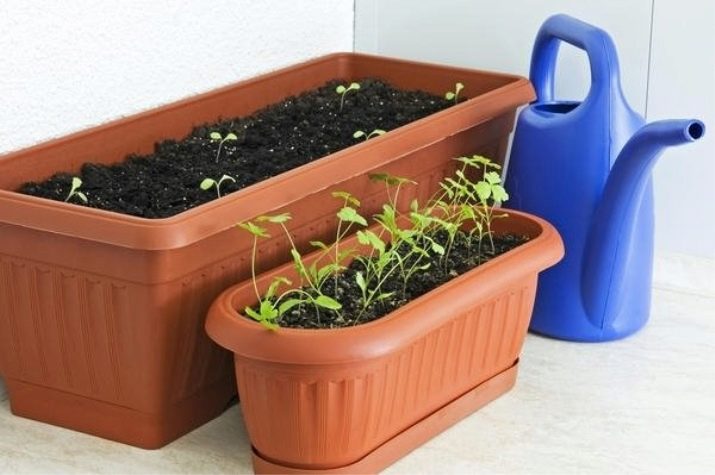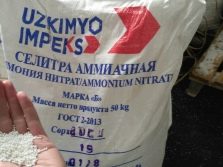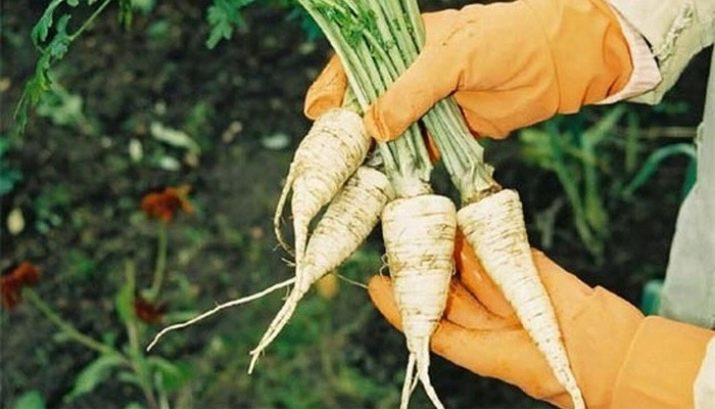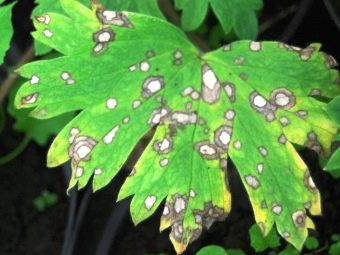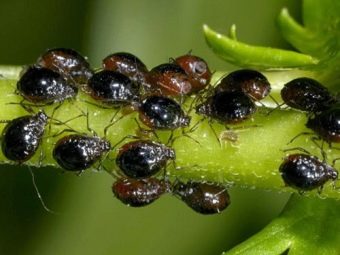Parsley root: cultivation and care, use, benefit and harm
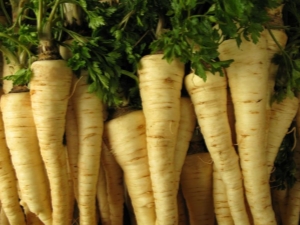
Parsley root is a useful plant that is able to please its owner with nutritious fruits for two years. The benefits and harms of this vegetable crop cause many disputes. Every gardener should be familiar with the rules of cultivation, care and use of root crops.
Characteristic
Parsley root belongs to the umbrella family and is a biennial plant. The height of the garden crop can reach one meter. The plant has a thickened root, the shape of which is similar to the spindle. The stem is straight and can branch. Foliage has a bright green color with a smooth surface. The shape of the leaves dissected and assembled into the outlet. Flowering root parsley begins in the middle of the summer season. During this period, small yellowish-green flowers appear on the plant.
Parsley root is different from the leaf with its leaves. The root foliage has a tough taste, so it is recommended to use it to create hot dishes. Due to the high temperature the leaves acquire the necessary tenderness.
- "Sugar". This variety is considered the oldest. She was bred in 1950. The ripening period is 95 days after emergence. Root crops grow to 75 grams. This variety is characterized by its universal characteristics, has delicious roots and foliage.
- "Alba". This variety is considered late ripening. It is grown in areas of many gardeners. Parsley ripens on day 170 after emergence. Fruits reach a weight of 230 grams. On one square meter ripens up to 5 kg of a crop.
- "Yield." This is a mid-season variety of root parsley. Fruits ripen on day 130 after emergence. The plant looks like a lush and sprawling bush, on which fragrant leaves are located. The fruits have a cone shape, weight reaches 120 grams, depending on the variety. Roots are eaten raw or preserved. Yield indicators reach 3.5 kg per square meter.
What is useful and where is it applied?
The benefits of parsley root are in the following qualities:
- The plant contains vitamins A, C, K, E, B. It is also rich in niacin, riboflavin, folates, choline, as well as elements such as Ca, Fe, Mg, Mr, P, Zn, Cu.
- Among the ingredients present is limoment, myristicin, eugenol.
- The use of parsley root is indicated for people with diabetes.
- The constant use of these fruits as food affects the output of uric acid, which contributes to the development of rheumatoid arthritis.
- Many people use parsley as an anti-inflammatory agent. The plant actively fights insect bites, pain in the teeth, as well as bruises.
- The human liver also has a beneficial effect: toxins are removed, the body is cleansed.
- Due to the fact that in parsley is an increased dose of calcium, it has a beneficial effect on the work of the spine. Due to folic acid, the plant reduces the concentration of amino acids and prevents the development of osteoporosis.
- Selenium, present in the list of ingredients, has a beneficial effect on the cardiovascular system.
- In folk medicine, this product is used to combat prostatitis, colds, diseases of the gastrointestinal tract, as well as to restore the menstrual cycle.
Parsley root is used not only as food, but also in the field of cosmetology. Many people are familiar with the whitening properties of the plant. For this reason, parsley extract is often found in creams, lotions, and skin tonics.
Can it hurt?
Despite its many positive properties, parsley can be harmful. It is prohibited to apply to women who bear a child. The juice of this plant can not be applied to people who suffer from neuritis or cystitis.
Agrotechnology
Growing root parsley under the power of each gardener. To grow a good crop, you need to learn the basic rules of agricultural technology.
In the open ground parsley should feel comfortable.
The landing site is selected based on several criteria.
- Landing should be made in the solar zone area. You will also need to provide her with protection from drafts and strong winds.
- Do not plant parsley after carrots, coriander or dill.
- Undesirable cultivation on heavy or clay soil.
- It is not recommended to sow parsley immediately after the addition of manure. This is due to the fact that the roots can branch.
When the site is selected, you should proceed to the preparation. Such events can be produced in the fall. This will require digging the site, the addition of humus. In the spring a place for landing will be ready. Additionally, it is recommended to add complex fertilizers to the soil, after which you can plant seedlings or seeds.
These plants do not tend to germinate quickly from seed. Therefore, the grain should be prepared.
Seeds are soaked in water for two days. The procedure is performed two weeks before landing. Twice a day it is necessary to replace the fluid.
While in liquid, seeds swell. After that, they are washed and poured a layer of small thickness on the gauze. The room must be kept warm temperature. On the fifth day, the seeds begin to germinate. After that, you need to remove them in the refrigerator for 12 days. Then the grains are dried to a flowing state.
Land should be prepared in the fall. It is allowed to add 5 kg of humus per square meter, 30 g of potassium salt or double superphosphate. In the spring, any phosphate or potash fertilizer will be required along with 50 g of ammonium nitrate.
Root parsley should be transplanted to a prepared garden bed. For these purposes, one should dig up and equip small furrows (depth 2 cm). The minimum distance between each row should be equal to 20 cm. Then fresh planting should be watered.
To exclude instantaneous evaporation of moisture, the bed is covered with a film for a short time. If in a city where a garden crop is planted, the presence of winter thaws is not observed, planting of seeds in the autumn season is allowed. Seeds planted in the spring, will begin to germinate within a couple of weeks.
Many gardeners believe that root parsley does not tolerate transplanting. This is due to the fact that the roots are injured during a dive, so the harvest will not be good. The truth in this opinion is present. Every summer resident should be aware that a dive is allowed to be carried out only if there is high-quality earthen dressing around the root system.
If you plan to grow through seedlings, you should be familiar with the following features:
- sowing of seeds is carried out in the second decade of March;
- it is necessary to prepare the necessary container, purchase ready-made soil, or make a nutrient mixture with your own hands;
- seedlings need to grow at a temperature that is 23-25 degrees;
- during this period, it is necessary to monitor the level of moisture, drying of the soil is not allowed;
- when the first green leaf is visible on the surface, the temperature should be lowered to 18 degrees;
- in the second decade of May, it is possible to begin transplanting sprouts for permanent residence.
With this method, you can get the root parsley using the seedling method. Most people grow a plant on the windowsill with this method.
Care
Root parsley will require systematic weeding along with loosening the beds. Also required to remove weeds. The first loosening should not be too deep - a maximum immersion of 5-6 cm is allowed. Further loosening is allowed to a depth of 15 cm.To ensure a good flow of air, after watering should loosen the land between the rows.
To root parsley pleased good yield, it will require thinning. This procedure is necessary for the root crops to produce full-fledged fruits that have enough space for growth. The first thinning is performed immediately after seedling emergence. Between plants should leave a distance of 2 cm.
A second thinning will be necessary in two weeks. At this stage, the parsley will grow and be strong. The distance between the seedlings should be 6 cm.
Parsley root grows best if it is watered regularly. Despite the fact that the plant is unpretentious, this procedure should be carried out continuously.
When watering the following rules should be followed:
- watering should be done in the morning or in the evening;
- Do not allow water to enter the sheet outlet, as it is prone to damage;
- in wet weather it is recommended to reduce the number of waterings;
- watering should be done during the ripening of the fruit (in August);
- one square meter will require about 20 liters of water.
Root parsley should be periodically fed. Many gardeners inject feed at a very early stage of development, before the parsley has blossomed and formed inflorescence. To do this, use nitrogen or potassium supplements.
The first time you can feed the plant at a time when several green leaves are formed on the surface of the earth. To do this, use 15 g of ammonium nitrate. The second feed is introduced after three weeks. This will require about 5 g of ammonium nitrate, 10 g of superphosphates and 5 g of potassium salt. The dosage is designed for one square meter.
Many people wonder when it is necessary to dig parsley roots. In most cases, the harvest begins in the last decade of September. Collection time may vary depending on the climatic zone in which the site is located.
Harvesting Guidelines
- Collect root parsley should be in dry and sunny weather. The first step is to cut the green mass and leave a small stump on the surface.
- Then you should start pulling the root from the soil. After that it should be left to dry.
- When the fruit dries, the excess ground is removed from them and the parsley is stored or used for food.
Diseases and pests
There are several common diseases that attack root parsley.
Among them are several diseases.
- White rot. This disease, which covers the top of the plant and eventually develops into sclerotia fungus. In the end, the plant begins to become softer, and the roots rot.
- Perinosporosis. The disease damages the green mass of parsley. The characteristic signs of the disease are chlorotic blotch on the foliage, after which they are transformed into yellow spots.
- Rust. Rusty spots appear on the leaves, which affect the entire plant. As a rule, the disease begins to develop at the beginning of the summer season.
- White spotting. The disease, which affects the lower foliage, stem with cuttings. The presence of pale spots on plants is considered to be characteristic signs. In the future, the spots become large and pycnids appear on them.
- Cercospora The disease attacks foliage with umbrellas and stems. The disease is expressed in the form of round or narrow yellow spots. The presence of brown spots.
- Gourd aphid nematode. In the past, the disease attacked only onions with garlic, but at the moment it can be found on the root parsley. The disease affects the lower part of the plants, as a result of which it begins to turn yellow and dries out.
- Carrot fly The disease provokes slower growth of parsley, as a result of which the leaves change their color.Green turns purple. Further coloring gets yellow color, and all foliage is showered.
- Carrot listobloshka. It is an insect that has a green color. The pest lays its larvae on the plant and affects the green mass.
About harvesting root parsley for the winter you will learn from this video.


















